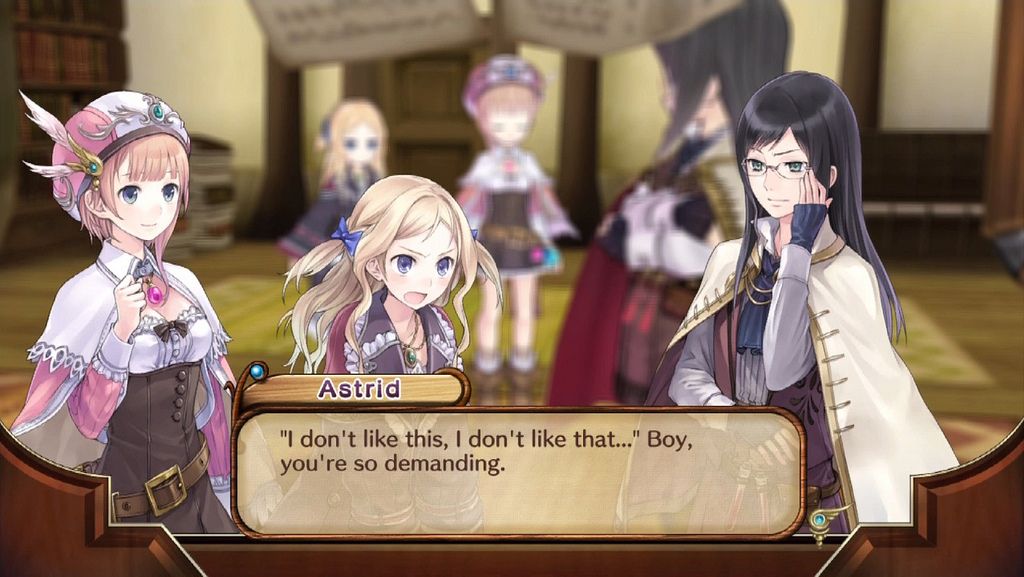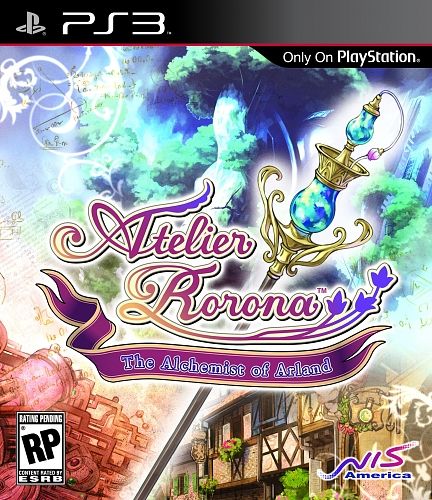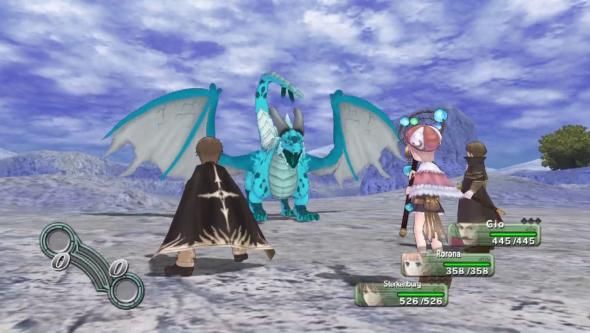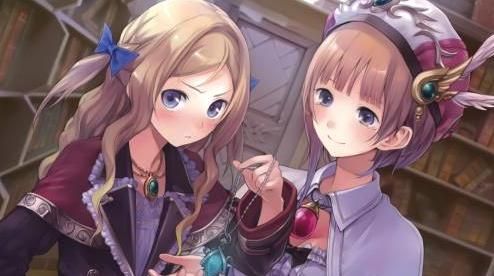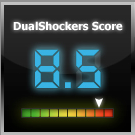The Atelier franchise is one that has been around longer than most people think, but the fact that it is more of a niche series leaves many people in the dark as to what exactly this new title is. Why is it on many people’s radar now? Simple - it’s the franchise’s first foray onto current generation consoles and its first dive into the realm of 3D-rendered visuals. I’ve always been a fan of alchemy-based games, of which the Atelier franchise isn’t unique to. However, no others really endear me to the characters as much as these games. So, let’s take a look at Atelier Rorona, the latest game for the franchise to hit North American shores, and see how it fares.
Atelier Rorona takes place mostly in and around the town of Arland (no surprise there). It focuses on an apprentice alchemist by the name of Rorolina Frixell, or Rorona for short. In fact, she has a penchant for shortening everyone’s name in some way, shape or form, getting visibly distraught when a name is too short to easily shorten it. This is one of the things that endears me to Rorona herself - she has a lot of mannerisms and quirkiness that tends to melt your heart, regardless of how you feel about her very clumsy, animé-stereotype demeanor.
The alchemist shop Rorona works at, which is run by a rather arrogant woman named Astrid, becomes the target of some higher-ups in the Kingdom. These guys want to shut the shop down, but there is one way to keep it up and running - prove to the kingdom that it can make a reasonable contribution to society. For some reason, this entire task falls back on Rorona, so she has to complete one alchemy-based assignment every three months. Failure to do so means the shop’s demise (and a game over for the player).
Yes, that is the entire premise of the game. It’s simple, to the point, yet oddly enticing at the same time. After all, there is something to be said about simpler narratives, especially when a game focuses on character interaction and game mechanics instead, which is the case here.
In the strictest sense of the term, this could be called a time management game. But, so could Persona 4. That doesn’t mean that you really have to worry about the passage of time every moment of the game. Although, it is more prominent here than with the aforementioned Persona title. You definitely have to at least be aware of time passing as you travel to different locations and synthesize products at your alchemy shop.
Therein lies the biggest challenge in this game - keeping up with everything you need (or want) to do, while still managing your time well to complete the story-related assignments on time. If you don’t, it’s hasta la vista, baby.
So, let’s take a look at exactly what things you have to do. First off, there is the main assignment, which typically tasks you to create some new concoction or item via synthesis, using ingredients that you’ll find in the field. Typically near the beginning of each chapter, you’ll have new manuals to purchase and possibly a new dungeon opening up (although this isn’t always the case). You can go out, gather your ingredients and begin synthesizing the items you need to complete this most important of assignments.
This comprises the meat of the story, and along the way, you’ll meet new friends and characters that will help you in various ways, as well as give you additional side quests to fulfill. Ah, the side quests. These became the bane of my existence, because I am a completionist. I quickly realized that there was absolutely no way I was going to be able to complete every single side quest that came up, as well as the main assignment, so after a while I just gave up trying. Can there ever be too much to do in an RPG? Possibly, depending on the game's design. That being the case, it seemed like some goals - such as completing every single side quest I could find - were just not possible because of the time management aspect, at least in my experience.
You can obtain side quests in various different ways. Within the castle itself there is an NPC you can speak to to take on these various tasks, which is where the bulk of them originate. These could either task you with creating or obtaining various items, or killing certain enemies. They typically have a deadline on them, as well. If you complete them before the deadline, you get the full reward price. Completing them after the deadline either offers you less of a reward or make you abandon the quest altogether. Eventually, there will be extra stuff you can do to give you bonuses when turning in a quest - such as having all items be quality 70 or above. These bonuses typically aren't necessary to turn in the assignment, but they do get you extra goodies if you meet them.
You can also pick up quests from friends that Rorona knows around town, and completing these specifically builds up a friendship level with that person, which leads to benefits down the line.
These tasks start off fairly easy, but get more difficult as the game progresses, especially when you start getting to the point where the item you produce has to be of a certain quality (not as a bonus, but as a requirement). There are so many tasks that refresh every couple in-game days that it is nearly impossible to keep up with them all, as I mentioned earlier.
The visual appeal of this title obviously leans toward the anime style, and that is perfectly fine by me. The cell-shaded visuals are fun and eye-catching. In other words, I don’t feel any need to have a game like this contain insanely detailed visuals like most people expect this generation. Graphics aren’t everything, and I had no problem with the visual style of Atelier Rorona. The story plays out with static character portraits, changing occasionally to represent the emotions of the character. But these are nicely drawn, and there are some full-motion anime cut scenes that are very well done and a joy to watch.
When we look at the audio side of things, the music is catchy and fits the upbeat, light-hearted style of the entire game. Although, it did get pretty repetative at times, especially the music playing in Rorona’s shop itself, which is where you spend quite a bit of time. The voice work is typically well done, also. I would expect nothing less from NISA. Rorona’s voice is endearing and not annoying, which I expected. Her English voice actress did a great job in letting the inflections in her voice come through to help create the character that Rorona is. This definitely played a large role in endearing myself to our heroine.
I saved discussing the battle system until later in this discussion because, for once, it really isn’t the focus of this RPG. The focus is the alchemy system and Rorona’s plight, the battle system is merely a means to an end. That being said, it is nothing special. It is a typical turn-based affair with a maximum of three party members at any given time (one always has to be Rorona).
The party can be made up of friends of Rorona’s that you hire in town for a piddly sum of coins, and some are most obviously better than others. You will notice a fairly high difficulty toward the beginning of the game, because of the limited healing items and the weaker party members. But, after a while, you get some heavy hitters available and tend to breeze through battles so fast they seem to almost become a tedious venture.
Each character has a series of special abilities that can be used, typically at the expensive of health. But, they do pack quite the punch. When a character levels up, they get a skill point that can be placed in any of their unlocked abilities to beef it up a bit. During combat itself, as the turns pass, the two other characters will get special abilities in the form of extra attacks or shielding mechanics.
For example, after a few turns, if an enemy is set to attack Rorona, both the other characters will get a message pop-up near their name, requesting that you hit either the L1 or R1 buttons (depending on which character you want to use). When you do this, they hop in front of Rorona, get into a defensive pose and take the force of the impact, thus protecting her. In the same manner, the characters can assist her. After she attacks, if it is available, the option will come up for you to choose either one or the other character to attack immediately following her action, effectively double-teaming the enemy.
Rorona also has the special ability to use items during battle, which no other party members have. Items can be used to damage enemies, protect friends or restore health.
Enemies show up on the field screen, and are usually easily avoidable if need be. Although, some are almost forced upon you as you move from one map area to the next. There are also actions you can perform on the field screen itself, such as throwing a bomb at a boulder that’s blocking your path. Typically these obstructions are placed so you don’t advance to a certain point on the map sooner than you should.
Another large aspect of the overall battle system is obtaining items to produce new weapons and armor for yourself. It got to the point where I had a hard time doing this, as well, simply because creating ingots or cloth took a long time, relatively speaking, so it started to become a burden to create these items and still have time for everything else I wanted to do, even though the weapon and armor synthesis itself didn’t cause time to pass.
Ultimately, all the battling and synthesizing and time managing will pay off, as there are multiple endings to be discovered, based on a variety of factors. The game definitely holds some replay value, and that is a plus.
There are some down sides to this title, as well. At times there can be some slow-down in the frame rate, but for the most part things progress smoothly. There can also be some odd animations at times. For example, every time you jump with Rorona it just looks like it doesn’t fit quite right.
The voice work is spot on, but the music sometimes gets repetitive, like I mentioned earlier. The dialog can also seem rather simplistic and forced at times. While this probably isn’t an issue for fans of the genre, it is going to be a huge turn-off to those who aren’t used to it.
I was concerned about the time management aspect of the game before I started playing. While it isn’t necessarily something you have to be concerned with every second of your play time, it is always there, looming overhead, and that only gets more pronounced as you work your way through the game. Locations take longer to get to, synthesis takes longer to complete and that main assignment deadline seems to sneak up on you faster than you would expect.
This wouldn’t be an issue if it weren’t for the fact that you have so much to do in the game. You eventually have to choose in favor of focusing almost solely on the main story assignment at hand, and ignore any other quests that you can’t complete immediately or in a day or two after you receive them. It also tends to limit exploration of the various field areas to a quick run-through to simply collect items, making mistakes in travel location decisions rather costly.
Speaking of mistakes, you darn well better save often and in separate save slots, because there is definitely some trial and error going on here. If you mess up your time management, you better hope you have a back-up save point earlier in the three-month period that you can go back to if things get out of hand. Also, you can fail at synthesis. This is the reason I would eventually make a note to save each time before I would synthesize anything - from a single item to a large batch.
Overall, there is a lot to love here - the characters are endearing, the synthesis system is deep and rewarding and the visuals are vibrant and appealing. But, Atelier Rorona is what it is - a genre favorite. Those who aren’t fans of JRPGs will likely not find much to go on here, but ultimately that isn’t the point. The point is, for fans of the genre, this is a solid game that is definitely a worthy successor to what has come before in the franchise and a solid JRPG entry in the PS3’s growing library of exclusive titles.

